
Meridian is the seventh largest city in the U.S. state of Mississippi, with a population of 41,148 at the 2010 census and an estimated population in 2018 of 36,347. It is the county seat of Lauderdale County and the principal city of the Meridian, Mississippi Micropolitan Statistical Area. Along major highways, the city is 93 mi (150 km) east of Jackson, Mississippi; 154 mi (248 km) southwest of Birmingham, Alabama; 202 mi (325 km) northeast of New Orleans, Louisiana; and 231 mi (372 km) southeast of Memphis, Tennessee.

Camp Nelson Confederate Cemetery is a historic cemetery located near Cabot in northern Lonoke County, Arkansas and is near the site of a Confederate military camp Camp Hope, where 1,500 Confederate soldiers died during an epidemic during the fall of 1862. Camp Nelson Cemetery is located on Rye Drive, just off Cherry Road, just off Mt. Carmel Road in north Lonoke County about 2 miles east of Cabot.

Walter Reed was a U.S. Army physician who in 1901 led the team that confirmed the theory of Cuban doctor Carlos Finlay that yellow fever is transmitted by a particular mosquito species rather than by direct contact. This insight gave impetus to the new fields of epidemiology and biomedicine, and most immediately allowed the resumption and completion of work on the Panama Canal (1904–1914) by the United States. Reed followed work started by Carlos Finlay and directed by George Miller Sternberg, who has been called the "first U.S. bacteriologist".

Oakland Cemetery is one of the largest cemetery green spaces in Atlanta, Georgia, U.S. Founded as Atlanta Cemetery in 1850 on six acres (2.4 hectares) of land southeast of the city, it was renamed in 1872 to reflect the large number of oak and magnolia trees growing in the area. By that time, the city had grown and the cemetery had enlarged correspondingly to the current 48 acres (190,000 m2). Since then, Atlanta has continued to expand so that the cemetery is now located in the center of the city. Oakland is an excellent example of a Victorian-style cemetery, and reflects the "garden cemetery" movement started and exemplified by Mount Auburn Cemetery in Massachusetts.

Maple Hill Cemetery is the oldest and largest cemetery in Huntsville, Alabama. Founded on two acres in about the year 1822, it now encompasses nearly 100 acres and contains over 80,000 burials. It was added to the Alabama Historical Commission's Historic Cemetery Register in 2008, and to the National Register of Historic Places in 2012. Its occupants include five governors of Alabama, five United States senators, and numerous other figures of local, state, and national note. It is located east of the Twickenham Historic District.

Richmond National Cemetery is a United States National Cemetery three miles (4.8 km) east of Richmond in Henrico County, Virginia. Administered by the United States Department of Veterans Affairs, it encompasses 9.7 acres (3.9 ha), and as of 2021 had more than 11,000 interments. It is closed to new interments. Richmond National Cemetery was listed on the National Register of Historic Places in 1995.
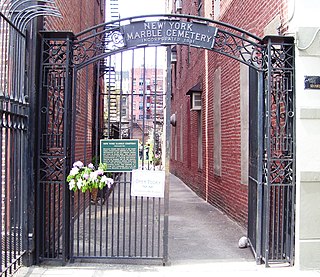
The New York Marble Cemetery is a burial ground established in 1830 in what is now the East Village of Manhattan. It occupies the interior of the block bounded by 2nd Street, Second Avenue, 3rd Street, and the Bowery. It is entered through an alleyway with an iron gate at each end, located between 41 and 43 Second Avenue. About 2,100 burials are recorded in the cemetery's written registers, most from prominent professional and merchant families in New York City.

The Minneapolis Pioneers and Soldiers Memorial Cemetery is the oldest extant cemetery in Minneapolis, Minnesota, United States. It was established in 1858 as a privately owned burial ground known as Minneapolis Cemetery or Layman's Cemetery. By 1919 it was full, with more than 27,000 bodies, and was closed by the city government. Only a handful of burials have taken place there since.
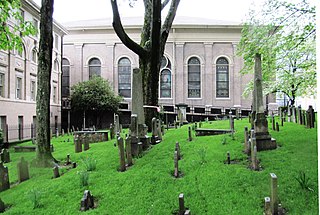
The First Presbyterian Church Graveyard is the oldest graveyard in Knoxville, Tennessee, United States. Established in the 1790s, the graveyard contains the graves of some of Knoxville's most prominent early residents, including territorial governor and Constitutional Convention delegate William Blount and Knoxville founder James White. In 1996, the graveyard was added to the National Register of Historic Places.

Catholic Cemetery, formerly known as the Stone Street Cemetery, is a historic 150-acre (61 ha) cemetery located in Mobile, Alabama. It was established in 1848 by Michael Portier, a native of Montbrison, France and the first Roman Catholic Bishop of Mobile. The cemetery contains roughly 18,000 burials and has plots dedicated to various Roman Catholic religious institutes, including the Brothers of the Sacred Heart, Daughters of Charity, Little Sisters of the Poor, and Sisters of Mercy. It was placed on the National Register of Historic Places on July 3, 1991 as a part of the Historic Roman Catholic Properties in Mobile Multiple Property Submission.

Oaklawn Cemetery is the first public burial ground in Tampa, Florida, United States. The location was deeded in the mid-19th century and was described as the final resting place for "White and Slave, Rich and Poor". Oaklawn Cemetery is located at the intersection of Morgan Street and Harrison Street in downtown Tampa, about two blocks South of I-275. It has approximately 1,700 graves.
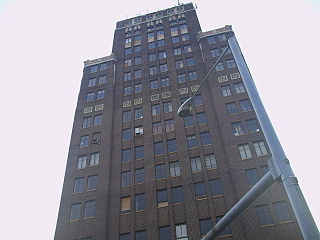
The history of Meridian, Mississippi begins in the early 19th century before European-American settlement. Originally settled by the Choctaw Indians, the land was bought by the United States according to the Treaty of Dancing Rabbit Creek in 1830. The city grew around the intersection of the Mobile and Ohio Railroad and the Southern Railway of Mississippi and developed a largely rail-based economy. Although much of the city was burned down in the Battle of Meridian during the American Civil War, the city was rebuilt and entered a "Golden Age." Between about 1890 and 1930, the city was the largest in Mississippi and a leading center for manufacturing in the Southern United States. After the decline of the railroading industry in the 1950s, the city's economy was devastated, resulting in a slow population decline. The population has continued to decline as the city has struggled to create a new, more modern economy based on newer industries. In the past 20 years or so, Meridian has attempted to revitalize the city's economy by attracting more business and industry to the city, most specifically the downtown area.
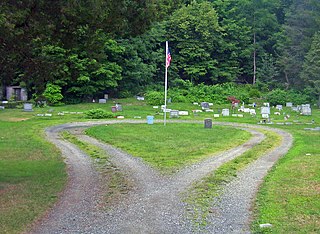
The Old Sloatsburg Cemetery is located at the end of Richard Street in Sloatsburg, New York, United States. It began as the Sloat family cemetery with the burial of Revolutionary War casualty John Sloat in 1781. After a half-century of inactivity, it gradually was expanded to include 1,200 graves by the time of the last burial in 1949.

Nundah Cemetery is a heritage-listed cemetery at 88 Hedley Avenue, Nundah, City of Brisbane, Queensland, Australia. It was built from 1840s to 1963. It is also known as German Station Cemetery. It was added to the Queensland Heritage Register on 21 October 1992.

There are nine historic districts in Meridian, Mississippi. Each of these districts is listed on the National Register of Historic Places. One district, Meridian Downtown Historic District, is a combination of two older districts, Meridian Urban Center Historic District and Union Station Historic District. Many architectural styles are present in the districts, most from the late 19th century and early 20th century, including Queen Anne, Colonial Revival, Italianate, Art Deco, Late Victorian, and Bungalow.

Mount Hope Cemetery is a historic cemetery in southern Boston, Massachusetts, between the neighborhoods of Roslindale and Mattapan.

Brandon Cemetery is located in Brandon, Mississippi, northeast of the Downtown Brandon Historic District. It is an 8.8 acre cemetery originally platted in 1831. The cemetery contains over 1,000 marked graves, and was added to the National Register of Historic Places in 2010.
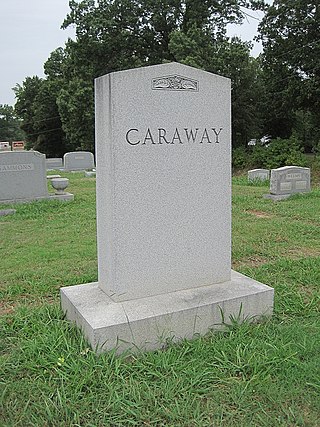
The US Sen. Hattie Caraway Gravesite is located in Oaklawn Cemetery on the west side of Jonesboro, Arkansas. It is the only surviving site in Arkansas associated with the life of Hattie Caraway (1878-1950), the first woman to be elected to a full term in the United States Senate. The gravesite consists of a family headstone, simply engraved "Caraway", and three footstones: one for the senator, one for her husband Thaddeus, whom she succeeded in the Senate, and their son Robert. The site is located on the western central edge of the cemetery.

Flemington Road Cemetery is a heritage-listed cemetery at Flemington Road, Bowen, Whitsunday Region, Queensland, Australia. It was built from 1878 to 1954. It is also known as Bowen Cemetery. It was added to the Queensland Heritage Register on 23 July 1999.
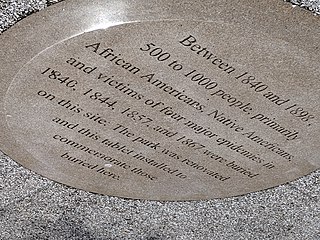
Old Town of Flushing Burial Ground is a historic cemetery located in Flushing, Queens, New York City. It was established in 1840 and known as The Olde Towne of Flushing Burial Ground. It was the result of Cholera and Smallpox epidemics in 1840 and 1844, added by town elders north of Flushing Cemetery due to fears of contamination of church burial grounds. Once known as "Pauper Burial Ground", "Colored Cemetery of Flushing" and "Martins Field", it was purchased by the New York City Department of Parks and Recreation on December 2, 1914, and renamed in 2009 to "The Olde Towne of Flushing Burial Ground".























